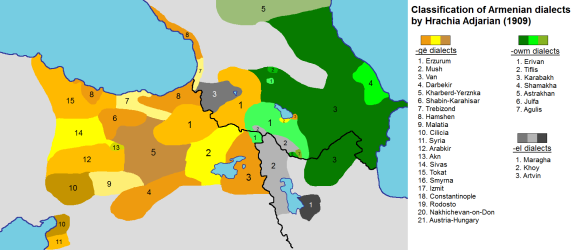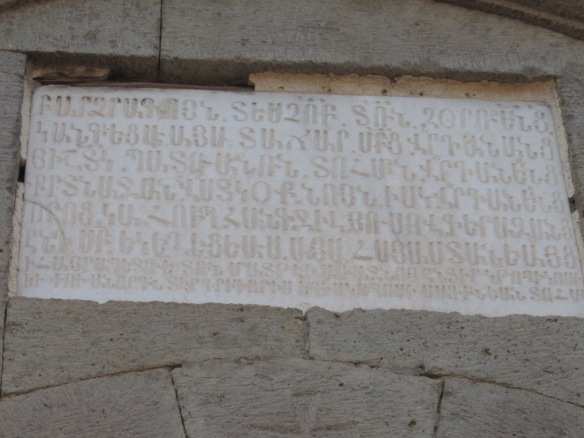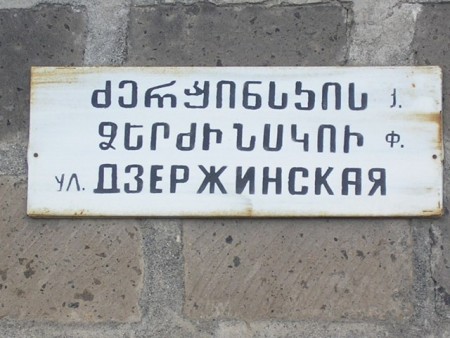Armenian (Armenian: hayeren, հայերեն) is a language historically spoken throughout the South Caucasus and in the eastern part of what is now Turkey. Today, as a result of a century of war and genocide, the native range of Armenian has been restricted to the modern country of Armenia, the semi-country of Nagorno Karabakh, northern Iran, and the Javakheti region of Georgia (or Javakhk; see Notes on Terminology). Many (perhaps most) Armenian speakers are scattered abroad, mostly in Russia, the United States, and various Middle Eastern countries.
Unlike Georgian, but like Russian and English, Armenian belongs to the Indo-European language family. It was once thought to be an Iranian language on account of extensive Iranian influence on its vocabulary, and today it is sometimes thought to be related to Greek. For the most part, though, Armenian is believed to be an Indo-European isolate, related only distantly to other languages.
Armenian is a pluricentric language, meaning that it has more than one literary standard (somewhat like the difference between British and American English). On the one hand there is Eastern Armenian, which is based on the Yerevan dialect. This is what is used in Armenia today, and more generally what was used by Armenians under Russian influence. On the other hand there is Western Armenian, which is based on the dialect of Istanbul. This is what was used by Armenians under Ottoman influence (basically those living in what is now Turkey). Most Western Armenians were murdered around the time of the First World War, and most of the remainder were deported. Thus Western Armenian is largely the variety used by Diaspora Armenians.
The Armenians of Javakheti are unusual in that they are speakers of a Western Armenian dialect still in their native range. In particular, they speak the dialect associated with the city of Eruzum (known in Armenian as Karin).

Armenian dialects shortly before the Armenian Genocide. Yellow indicates Western Armenian, green indicates Eastern Armenian. Javakheti is in the first yellow region.
The Armenian alphabet was invented by a priest named Mesrop Mashtots in connection with the spread of Christianity around 400 AD. Armenians like to say that he also invented the Georgian alphabet, but that is almost certainly false. To outsiders the two alphabets might appear to be the same jumble of squiggles, but in fact they don’t really look alike. The most notable difference between them is that the Armenian alphabet has upper and lower cases, whereas the Georgian alphabet does not.
Shortly after their invasion of Armenia, the Soviets instituted an orthography reform. Prior to this, Armenian spelling was somewhat like English and French spelling, reflecting etymology and archaic forms; the reform aimed to make it simply phonetic. Naturally, this affected Armenians in the Soviet sphere and did not affect those outside of it. Broadly speaking, this meant that Eastern Armenian would be written with reformed orthography, while Western Armenian (used by Diaspora Armenians) retained its traditional orthography. (Exceptions to this rule include Iranian Armenians, who were Eastern but not Soviet, and Javakheti Armenians, who were Western and Soviet.)
I don’t understand exactly what was changed, but apparently it’s still a contentious issue. See: an argument in favor of reform adoption by Diaspora Armenians and an argument in favor of reversion by the Armenian state to traditional spelling. As you might expect from a hard-line traditionalist, the latter argument is completely nuts.

From a church in Akhaltsikhe. According to a commenter, the inscription is in Classical Armenian with traditional orthography.
Like Georgians, Armenians are frequently multi-lingual. Knowledge of Russian, of course, is widespread in Armenia. Javakheti Armenians still rely on Russian as a lingua franca, since they tend to know little Georgian. I tried speaking Georgian when I was there, and it seemed to me that the people I talked to knew about as much as me. I actually met a Georgian woman there who told me that she was living with an Armenian family in Akhalkalaki and teaching Georgian in the town school. This is exactly what I was doing in Georgia as a TLG teacher.




Thanks for all the interesting info on Georgia (and now Armenia too!). I’m planning a holiday in both countries and can’t wait to see all those weird squiggly letters and try some strange Georgian fruit (and wine of course). Keep up the nice blog!
Thanks! I’ll keep an eye out for a post about your trip.
Reblogged this on White Lies.
Pingback: The Northeast Caucasian Language Family | georgiasomethingyouknowwhatever
Pingback: Flags of Georgia, Azerbaijan, Armenia, etc | georgiasomethingyouknowwhatever
Pingback: The Armenian Alphabet: Pictures and Miscellania | georgiasomethingyouknowwhatever
Pingback: Sayat-Nova | georgiasomethingyouknowwhatever
The inscription on the wall of Akhaltsikhe church is in Classical Armenian (not Modern) with traditional orthography, with heavy use of ligatures and abbreviations.
The post has been updated!